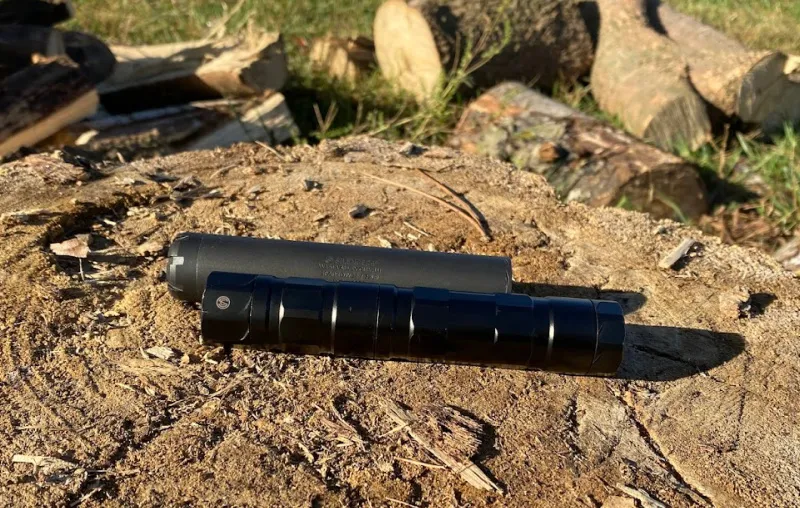[[“value”:”
Thank you for reading this post, don't forget to follow and signup for notifications!
David Higginbotham
Suppressing a handgun can come with some hidden complications. Those of us who regularly shoot pistols with silencers will talk about Nielsen devices and pistons—both of which can be tricky for the uninitiated. Rimfire pistols, though, are much less stressful and offer a great way to learn the ropes of shooting suppressed.
Why Suppress a Rimfire Pistol?
A suppressed rimfire pistol is one of the easiest and most rewarding setups for shooters interested in quiet, accurate range time. With minimal recoil, lower cost, and simple threading options, rimfires make the perfect platform to understand how suppressors work before moving on to centerfire calibers.
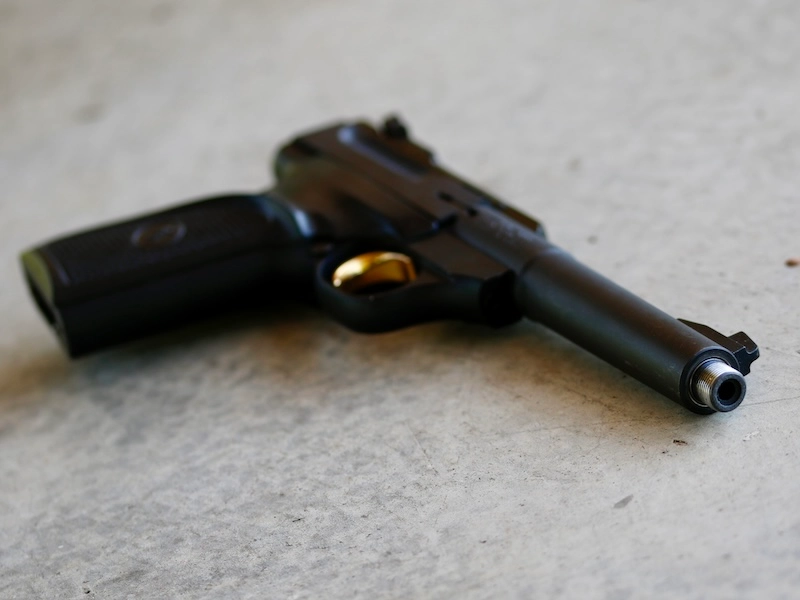
Suppressor Mounting Systems for Rimfires
Direct Thread: The Simplest Option
If the barrel on your rimfire pistol doesn’t move or shift when you rack the slide, odds are it’s fixed. By “move,” we mean the barrel doesn’t tip up or wobble when cycling. Or maybe the “slide” is actually a short block directly behind the barrel. Either way, a fixed barrel setup is as easy as it gets when adding a suppressor.
The blowback action is driven rearward by the pressure created when the round fires. For these systems, all you need to know is your barrel’s thread pitch. Match it to the suppressor’s thread pitch, screw them together, seat it firmly, and you’re ready for the range.
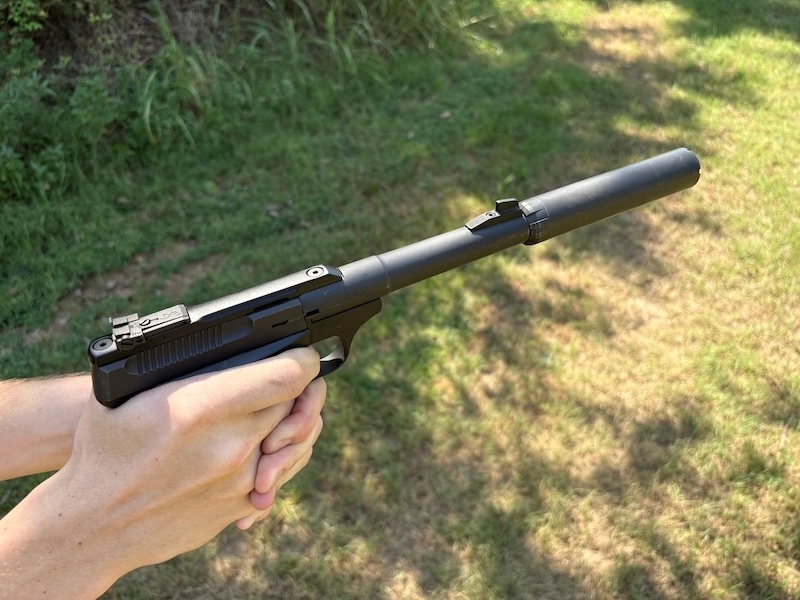
Rimfire Pistols Ideal for Direct Thread Suppressors
I’ve been shooting this Browning Buckmark with a Sparrow for more than a decade. It is my go-to. The Ruger Mark series guns, when threaded, are also ideal. Ruger’s 22/45, and Smith & Wesson’s SW22 Victory are also excellent options.
Almost every major manufacturer that makes a .22 LR pistol offers at least one version that is threaded. If yours isn’t threaded—like an older Ruger Mark III—it may cost nearly as much to have it threaded as to buy a new gun. Whether to modify or upgrade is a personal decision.
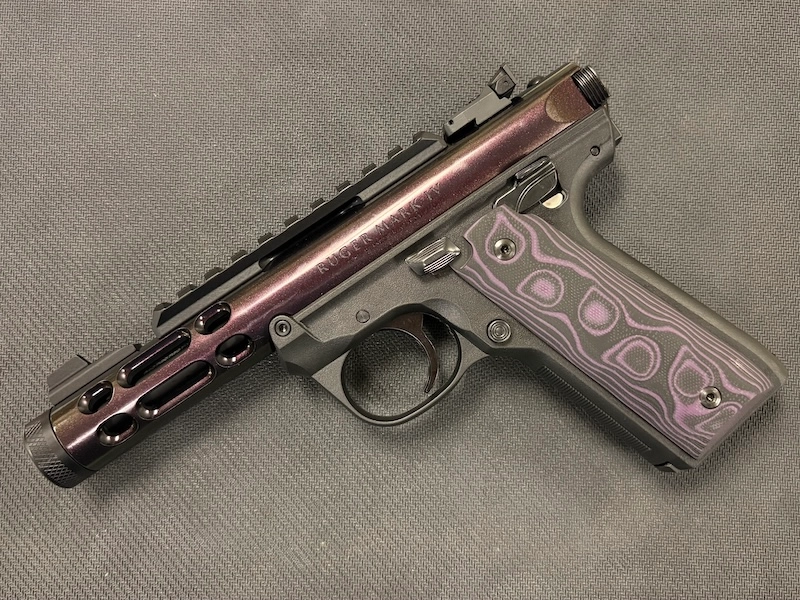
Short-Recoil Rimfires and Hybrid Systems
Some rimfire pistols are designed to mimic their centerfire counterparts. These typically will use a combination of blowback and short recoil. A few examples include the Taurus TX22, Ruger SW22, Smith & Wesson M&P 22.
These hybrid systems can be finicky, even unsuppressed. They rely on blowback to start the action’s movement, then mimic the motion of short recoil. Add the weight of a suppressor, and the action may stall—similar to what happens when shooting a blowback gun like the Buckmark with underpowered subsonic ammo.
However, many rimfires can handle light suppressors such as the SilencerCo Sparrow without issue. Even .22 WMR pistols usually don’t require a Nielsen device.
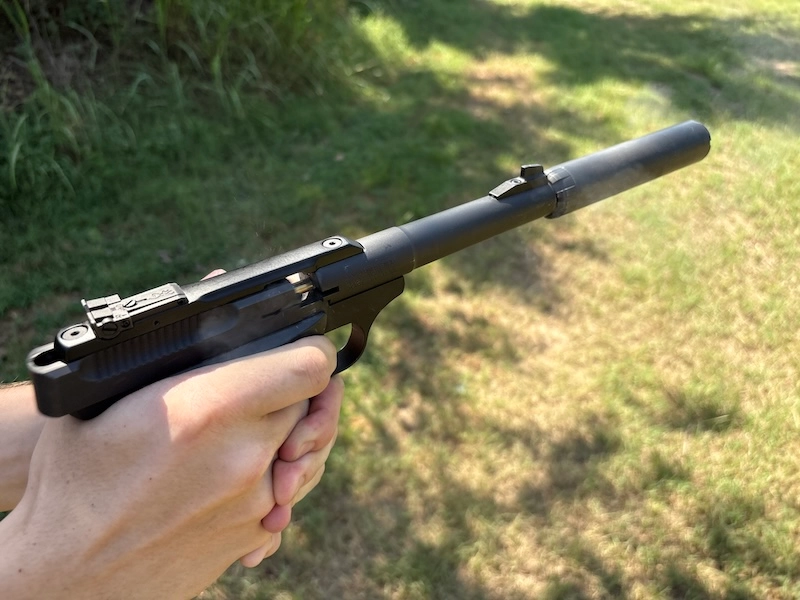
When You Need a Nielsen Device (and When You Don’t)
Rimfire pistols rarely need one. Most have fixed barrels, and even those that don’t are light enough that the added suppressor weight won’t affect cycling.
To appreciate how easy rimfire suppression is, it helps to understand why centerfire pistols are different.
Short-recoil systems require the barrel to travel rearward before disconnecting from the slide. This motion happens in milliseconds, and guns are finely tuned for it. Most 9mm, .40 S&W, .45 ACP, and even some .380 ACP pistols use this system.
Attaching a suppressor adds weight to the barrel, which can disrupt that delicate timing. A Nielsen device solves this by using a spring-loaded piston that lets the barrel move freely while the suppressor remains still.
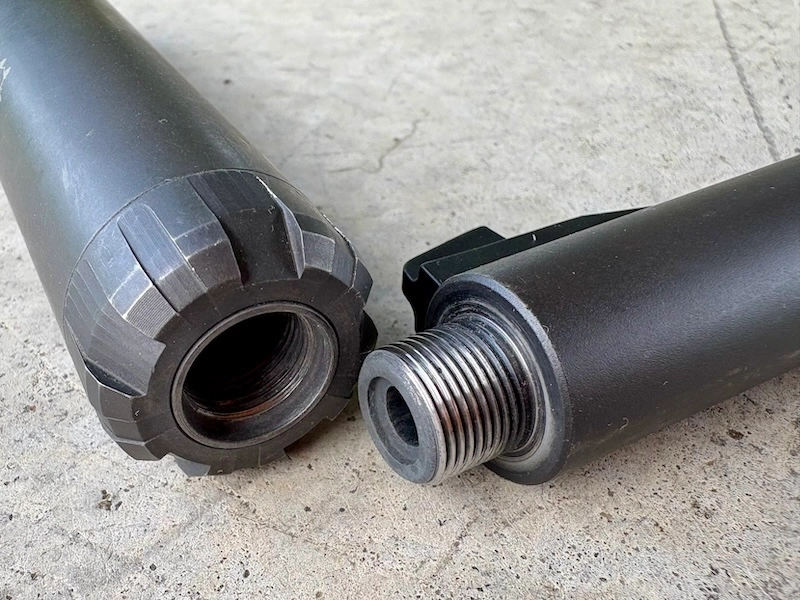
Choosing the Right Ammo for a Suppressed Rimfire
Subsonic vs. Supersonic .22 LR
Most .22 LR ammo cycles fine, suppressed or not. Hotter loads like CCI Mini-Mags cycle better but often break the sound barrier, producing a noticeable crack. For the quietest shooting, use subsonic .22 LR, which stays below that threshold. There are performance differences down range.
If you fire a round and the action doesn’t cycle, it’s an easy fix—just pull back and release the slide. If there’s no jam (and there rarely is), the spent case ejects and the next round feeds normally.
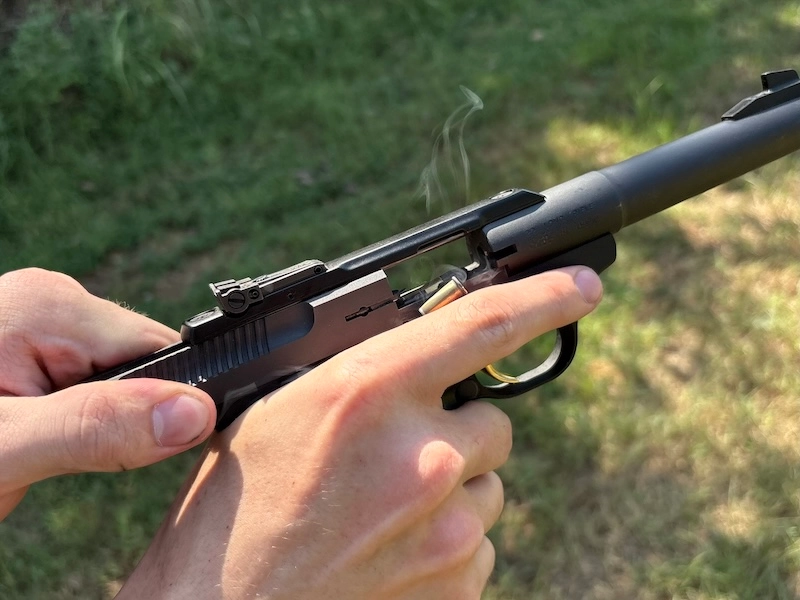
Power and Bullet Drop
Subsonic .22 LR varies in power. Manufacturers typically measure velocity with a 16-inch barrel, which gives powder time to burn fully. Most subsonic rounds aim for about 1,050 FPS to stay below the 1,125 FPS sound barrier.
When fired from a pistol, velocity drops because there is less barrel for the powder to burn in. That’s why subsonic ammo may cycle a suppressed Ruger 10/22 but not a Ruger 22/45 with a 3-inch barrel. The reduced velocity also means less effective range and more bullet drop.
Bullet Deformation and Hunting Performance
Lead projectiles deform when they strike targets, which can be a benefit when hunting. If you’re shooting small game with a suppressed rimfire pistol, bullet design matters. A hollow point that expands on impact helps prevent overpenetration while transferring energy efficiently.
Shot placement is everything, but pairing that with proper bullet construction increases your chances of a clean, ethical kill.
CCI’s Subsonic .22 LR uses a 40-grain hollow point and performs well in suppressed setups. For even quieter shots, the CCI Quiet-22 runs a 40-grain solid lead bullet at roughly 700 FPS, trading velocity for reduced report.
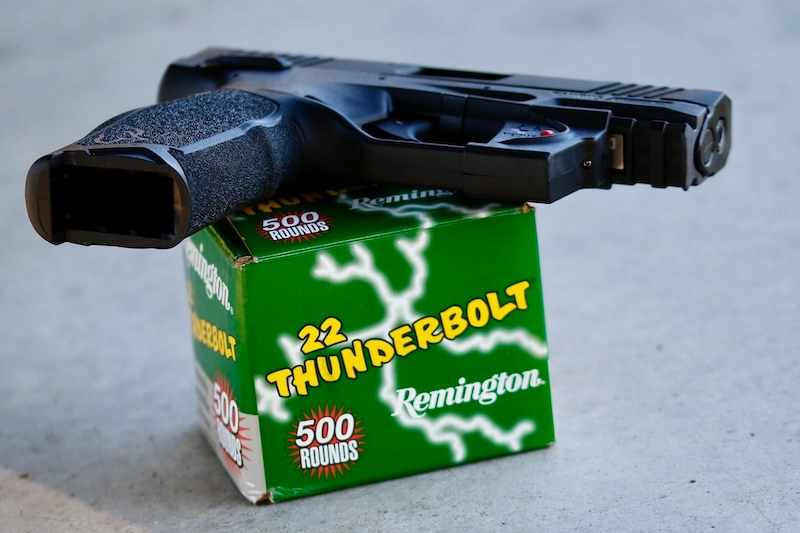
Slower Rimfire Options
Beyond .22 LR, there’s .22 Long, .22 Short, and .22 Colibri—each progressively less powerful. They’re rarely used today but once popular in 19th-century indoor “parlor” shooting.
As power drops, squibs become a concern. If you fire and don’t hear an impact when shooting suppressed, make the gun safe, clear the chamber, and check the barrel. A weak charge or buildup could leave a bullet stuck in the bore.
Faster Rimfire Options
Always check your suppressor’s rating. The SilencerCo Sparrow and Switchback are both rated for magnum rimfire rounds. The Switchback even handles automatic .22 LR fire, .17 WSM, .17 HMR, .22 WMR, .22 Hornet, and 5.7x28mm.
Magnum rimfire rounds are effective for small-game hunting, offering stronger terminal performance at longer ranges.
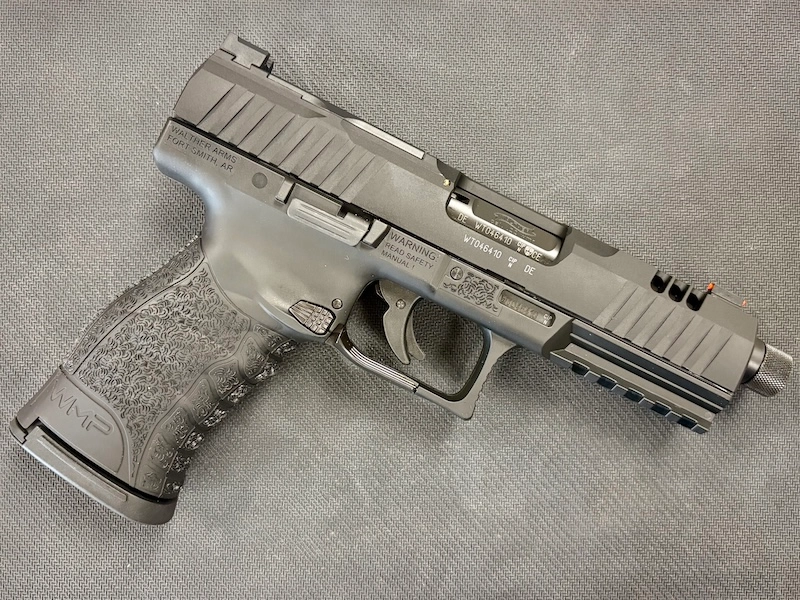
Rimfire Suppressor Recommendations
Once you’ve chosen your pistol and ammo, it’s time to cut the noise.
The SilencerCo Sparrow 22 remains a classic. It’s simple, durable, and easy to clean—essential for rimfire use, since .22 LR is notoriously dirty. After thousands of rounds, it continues to perform flawlessly.
The SilencerCo Switchback 22 takes modularity to another level. It can be configured in multiple lengths, and by reversing the baffles, you can adjust suppression performance. Run it short for compact carry or full-length for maximum quiet.
Both the Sparrow 22 and Switchback 22 are excellent dedicated rimfire suppressors. No matter which one you choose, a suppressed rimfire is genuinely a solid tool. I have used my Sparrow as a teaching tool. I’ve used it hunting. Mostly, it has served as a true silencer, keeping plinking quiet.
Range Tips and Maintenance
Rimfire suppressors accumulate carbon and lead quickly. Disassemble and clean them regularly—typically every 1,000 to 2,000 rounds—to maintain peak performance.
If cycling issues arise, first check your ammo choice, then inspect for fouling in the suppressor or chamber area. Switching to slightly hotter ammo or cleaning the baffles usually resolves it.
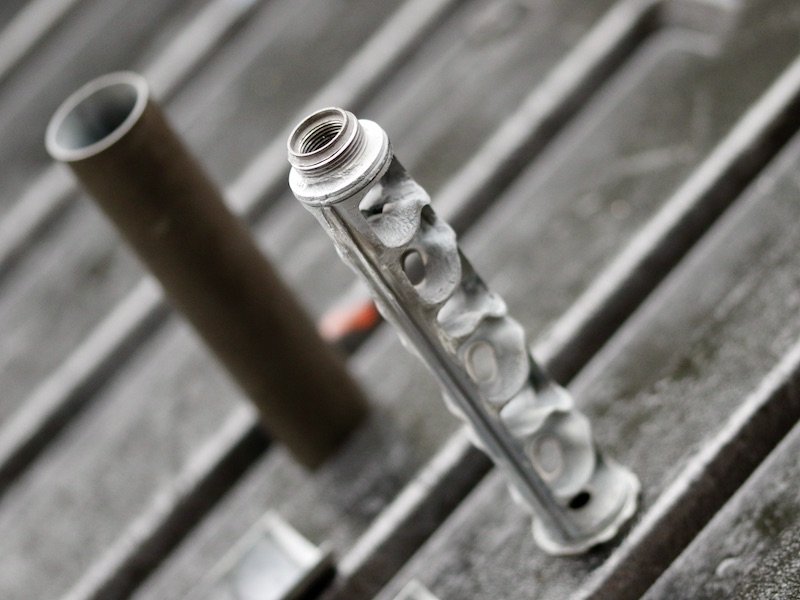
Final Thoughts
No matter what you choose, a suppressed rimfire pistol is a practical and enjoyable tool. The combination of low cost, minimal recoil, and quiet operation makes it perfect for both new shooters and seasoned enthusiasts.
A quality suppressor like the Sparrow or Switchback adds versatility to any .22 pistol, whether you’re plinking at the range, teaching a new shooter, or taking small game in the field.
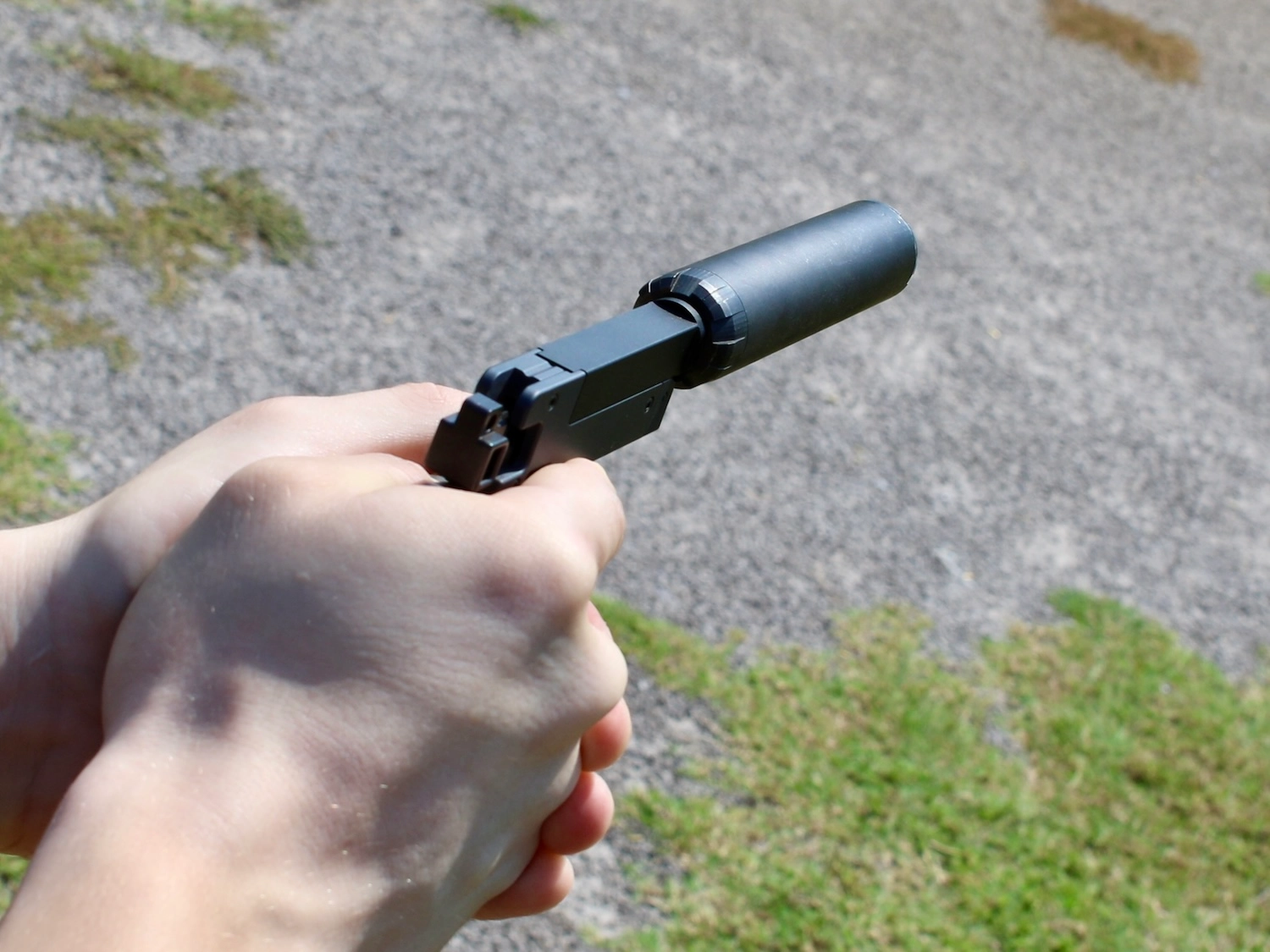
FAQ
Do rimfire pistols need a Nielsen device?
Most fixed-barrel rimfires do not. A Nielsen device is designed for centerfire pistols with short-recoil operation.
What’s the best ammo for a suppressed .22 pistol?
Subsonic .22 LR provides the quietest performance. For hunting, a 40-grain hollow point like CCI Subsonic is an excellent choice.
Will subsonic .22 LR still cycle my pistol?
It depends on the barrel length and load. Some shorter pistols may require slightly hotter rounds for reliable cycling.
How often should I clean my rimfire suppressor?
Clean every 1,000–2,000 rounds, or sooner if accuracy or cycling declines. Rimfire ammo creates heavy residue buildup.
Are .22 Magnum pistols good for suppression?
Yes, but confirm your suppressor’s caliber rating first. Some cans, like the Sparrow and Switchback, are rated up to .22 WMR and beyond.
David Higginbotham
The post Rimfire Pistol Suppressor Guide: Mounts, Ammo, & Top Pics appeared first on SilencerCo.
“]]



